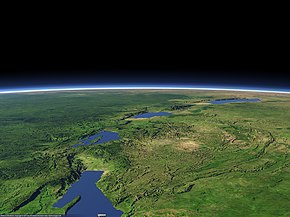East African Rift
[6] The Davie Ridge ranges between 30–120 km (19–75 mi) wide, with a west-facing scarp (east-plunging arch) along the southern half of its length that rises to 2,300 m (7,500 ft) above the sea floor.[12] According to marine geologist Kathleen Crane, the rift could eventually cause eastern Africa to separate from the mainland, although this potential event could take tens of millions of years.The varying geochemical signatures of a suite of Ethiopian lavas suggest multiple plume sources: at least one of deep mantle origin, and one from within the subcontinental lithosphere.[19][20] Parallel to geological and geophysical measures (e.g. isotope ratios and seismic velocities) it is constructive to test hypotheses on computer based geodynamical models.[22] Prior to the rift's formation, enormous continental flood basalts erupted, uplifting the Ethiopian, Somali, and East African plateaus.There was also the reactivation of a pre-Cambrian weakness in the crust, a suture zone of multiple cratons, displacement along large boundary faults, and the development of deep asymmetric basins.[23] A large volume of continental flood basalts erupted during the Oligocene, with the majority of the volcanism coinciding with the opening of the Red Sea and the Gulf of Aden approximately 30 Ma.[24] Notable active examples of EAR volcanism include Erta Ale, Dalaffilla (also called Gabuli, Alu-Dalafilla), and Ol Doinyo Lengai.Erta Ale is a basaltic shield volcano in the Afar Region of northeastern Ethiopia, active continuously since at least 1967,[25] with a summit lava lake documented since at least 1906.[35] The Somali Jet supplies water vapour for the high rainfall during the Indian Monsoon[36] and is responsible for roughly half the global cross-equatorial atmospheric mass flux in the lower-branch of Hadley Circulation.The bones of several hominid ancestors of modern humans have been found here, including those of "Lucy", a partial australopithecine skeleton discovered by anthropologist Donald Johanson dating back over 3 million years.[39] In 2008, two other hominid ancestors were discovered here: a 10-million-year-old ape called Chororapithecus abyssinicus, found in the Afar rift in eastern Ethiopia, and Nakalipithecus nakayamai, which is also 10 million years old.



East AfricaAfar TriangleAfrican plateSomaliMioceneGreat Rift ValleyAsia Minordivergenttectonic plateboundarySomali plateNubian plateVictoria microplateRovumaLwandleAfrican Great LakesAfar triple junctionRed Sea RiftAden RidgeGulf of AdenGregory RiftMain Ethiopian RiftAlbertine RiftCongo DRUgandaRwandaBurundiTanzaniaZambiaLake MalawiMozambiquegrabenssuperplumemantle plumesmagmatismplate tectonicsintrusionslithospheremid-ocean ridgeKathleen Cranerare earthisotopesxenolithsseismic tomographyP waveS waveupper mantleTanzania cratoncontinental flood basaltsEthiopiansuture zonecratonsfaultsLake AlbertRwenzori MountainsLake EdwardVirunga MountainsLake KivuLake Tanganyikacontinental crustKaapvaal cratonsgreenstone beltstonalitesmineral resourcesOligoceneMount KilimanjaroMount KenyaMount LongonotMenengaiMount KarisimbiMount NyiragongoMount MeruMount ElgonCrater HighlandsErta AleDalaffillaOl Doinyo LengaiHolocenenatrocarbonatiteviscosities17 in Kenya9 in TanzaniaearthquakesFocal mechanismEthiopian HighlandsLake Victorialake breeze systemsZambeziCentral AfricaCongo BasinrainforestaridificationIndian OceanIndian MonsoonHadley CirculationHuman evolutionTimeline of human evolutionhominidaustralopithecineDonald JohansonRichardMary LeakeyChororapithecus abyssinicusNakalipithecus nakayamaiBaikal Rift ZoneNorthern Cordilleran Volcanic ProvinceWest Antarctic Rift SystemWest and Central African Rift SystemEbinger, CynthiaEarth and Planetary Science LettersBibcodeNewsweekScience DailyEbinger, C. J.National Geographic SocietyGlobal Volcanism ProgramSmithsonian InstitutionPlatesLwandle plateMadagascar plateRovuma plateshieldsArabian-Nubian ShieldCongo CratonKaapvaal CratonKalahari Craton